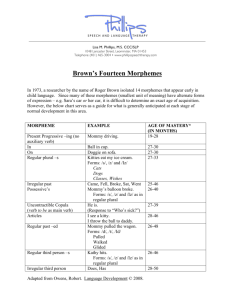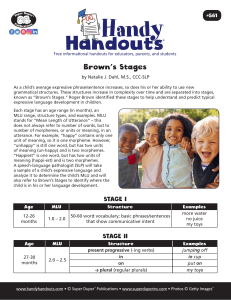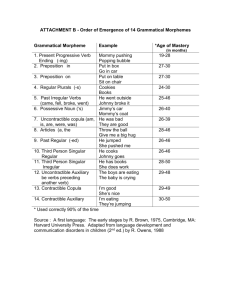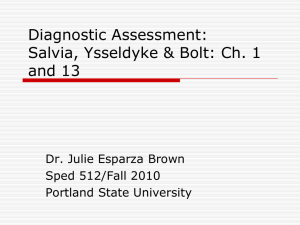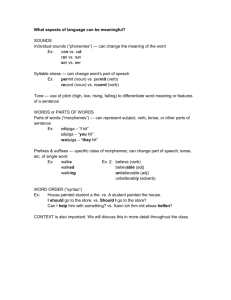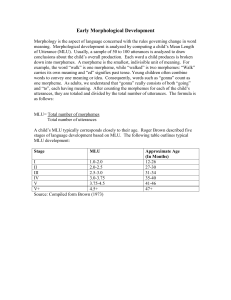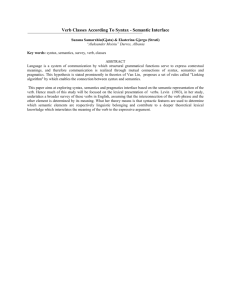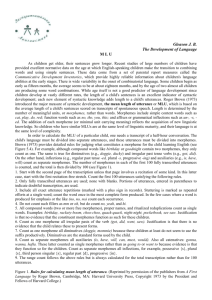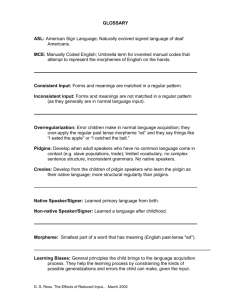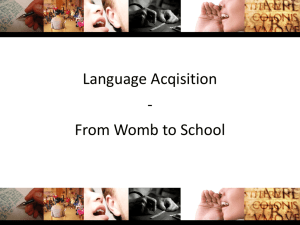Spoken Language Acquisition
advertisement
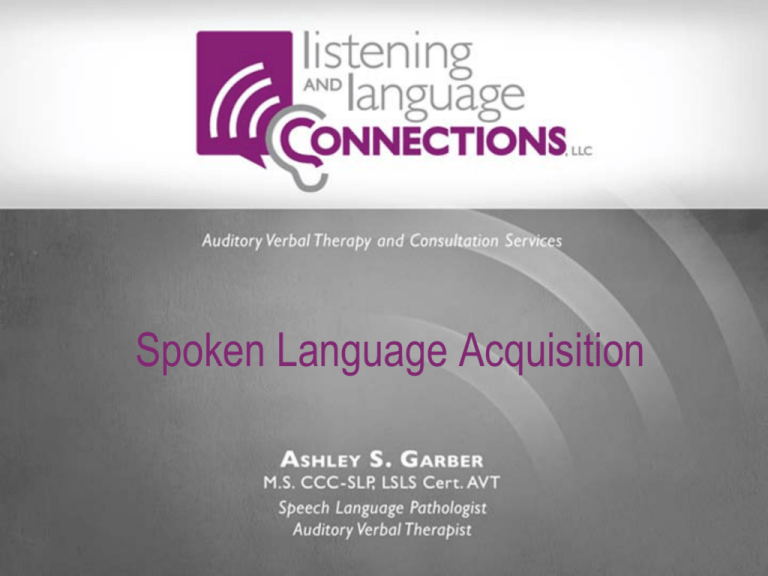
Spoken Language Acquisition Agenda • Exercise • Typical Language Development • Assessment of Language Developmental vs. Remedial Approaches • One of primary tenants of auditory-verbal approach is that children with hearing loss have the ability (with appropriate audiological management) to learn language in a fashion similar to peers with typical hearing function • What does that mean? Typical Language Development What is normal?? Test Yourself…. • What pre-symbolic skills are necessary prior to development of meaningful communication? • How many single words does a typical hearing child use before he is ready for the 2 word stage? • How many words do typical hearing children use before they begin formal reading instruction? • How many words does a child at language age 2 have to learn in the next 12 months in order to reach language age 3? Cognition ….. Auditory • 0-1 mos: Reflexes • 1-4 mo: Primary Circular Reactions (Repetitions/imitations of actions involving self) • 4-8 mo: Secondary Circular Reactions (Imitates adult actions, searches for disappearing object) • 8-12 mo: Coordination of Secondary Reactions (Anticipates actions, develops means/ends relationships) • 0-3 months: Auditory Awareness and Attention • 3-6 months: Discrimination and Auditory Feedback • 6-9 months: Localization and Babbling • 9-12 months: Auditory Processing Put them together… Typical Language Development • Cooing (2 to 4 months) – vowel-like sounds • Babbling (4 to 12 months) – – – – vocal play using all of the possible phonemes raspberries, bubbles, etc. reduplicated (e.g. mamama) variegated (e.g. abadabagu) Typical Language Development • First Words (9-12 months) – meaningful approximations • Word Combinations (18 to 24 months) – by 20 months children may have ~50 words – jargon – • talking with intonation as if making sentences • real words mixed in with babble sounds – mixing and matching single words to express a variety of intentions (e.g. “mama shoe”) Typical Language Development • Simple Sentences (24 to 36 months) – hundreds of words in their vocabularies – combining several words (e.g. “Want more juice”) • Sentence Development (36+ months) – using adult-like structures by 5 years of age – articulation and grammar still not perfect Development: Looking More Closely Precursory Skills for Symbolic Communication • Early Communicative Behaviors • Video 1 – Max, Video 2 - ? – – – – – – Eye contact Signaling of attention Turn taking Joint attention Pointing and joint reference Imitating objects with actions • Absence of these behaviors can result in – Delayed rate of progress – Set-backs in parent child bonding – Unnecessary difficulties with language processing • Therapist/teacher must work (with parent) to develop absent skills Pre-Verbal Communicative Intent • Attention seeking – To self – To events, objects, other people • Requesting – objects, – Information – Action • • • • Greeting Transferring Protesting/Rejecting Responding/ Acknowledging • Informing (Roth and Spekman, JSHD 1984) First Words • Characteristics of Early Vocabulary – Includes receptive and expressive forms • Comprehension precedes production 50:10 – Can be adult-based or idiosyncratic – Has referential stability (imitative or spontaneous) – Has phonetic stability (Owens, 1996) The First 50 Words • Of 1st 100 understood: – Nouns – 56%, Verbs – 36% – Modifiers – 3%, Social – 5% • Of 1st 50 used: – Nouns – 61% (mostly referential: individual objects, persons, etc.) – Action 19% – Modifiers – 10% – Social – 10% (Owens,1996) Early Vocabulary Acquisition • • • • • • • 12 months 18 months 2 years 3 years 4 years 5 years 6 years 1st word appears 20 -100 words 300 words 900 words 1500 words 2500 words 13,000 words To go on to higher education, one needs to know 100,000 words How are First Words Used? • In context to express larger meanings – “cookie” can mean • “I want a cookie” • “There’s a cookie” – “hit” can mean • “He hit me” • “I hit the ball” • With preference for encoding the new or changed element in the environment – “bye bye” when an object disappears from sight (Owens, 1996) Intention Expressed at the Single Word Level • Naming • Commenting • Requesting objects – Present – Absent • Requesting action • Requesting information • Responding • Protesting/Rejecting • Attention Seeking • Greeting Roth and Spekman, JSHD 1984) Over and Underextension • As child gains knowledge about the world, s/he refines meanings of words – makes hypotheses about underlying concepts – extends his current meanings to include new examples • Underextension – Child under-applies meaning and assigns too few examples – E.g. uses word “chair” only for his specific highchair • Overextension – Meanings are too broad, contain more examples that adult meaning – e.g. calling all men “daddy” Two Word Combinations • Once a child has approximately 50 words in his vocabulary, he will begin to combine them • Bloom and Lahey referred to early combination rules as “semantic/syntactic” – components are meaning based – Follow word-order relationships Combination Types • • • • • • • Agent + action (“Daddy eat”) Action + object (“throw ball”) Agent + object (“Daddy ball”) Entity + attribute (“big shoe”) Possessor + possession (“mommy shoe”) Recurrence (“more cookie”) Nonexistence/disappearance/rejection (“gone cookie”, “no bed”) • Demonstrative + entity (“this cup”) • Entity + locative (“doggy bed”) • Action + locative (“throw me”) Multi Word Combinations • Once ~ ½ of a child’s utterances contain 2 words, he will begin to create longer combinations • Most common – Agent + action + object – Agent + action + location • Formed in 2 ways – Recombination • “Daddy throw” and “throw ball” becomes “Daddy throw ball” – Expansion • “Eat cookie” becomes “Eat big cookie” 7-12 months • Cognitively: exploring toys, anticipating outcomes, recognizing object permanence, using objects functionally, imitating actions • Communication: vocalizes for attention, listens to others, receptive vocabulary growing, jargoning, follows commands, may be using first words 12 – 24 months • At 15 months – 4-6 words expressively – Will point to toys, animals, persons named – Solitary play, imitates housework, likes music and dancing • At 18 months – – – – 20 – 50 words expressively Begins 2 word combinations Identifies body parts Uses own name 12 – 24 months • 18 – 24 months – Vocabulary explosion! From 20 to 300 – Parallel play – Syntax: • Personal pronouns: I, mine • Present progressive beginning (-ing verbs) 24 – 36 Months • • • • Brown’s late Stage I – Stage III 200 – 300 word vocabulary by 2nd birthday Symbolic play Syntax: short incomplete sentences – – – – – – Prepositions: in/on 24 months, under 36 months Pronouns: I, me, you Verb endings: -ing, irregular past, reg. Past, 3rd person –s Plural: -s 27 – 33 months Subject + Verb + Object 30 months Subject + Copula + Complement (30 months) 36 – 48 Months • • • • • Brown’s Stages IV – V+ Vocabulary: 900 – 1000 words Can follow 2 step commands Cooperative play begins Takes turns, shares (sometimes!) 36 – 48 Months cont. • Syntax: – 3 – 4 word sentences: simple construction – Prepositions: next to 40 months; behind/in back/in front 48 months – Family terms – Pronouns – Superlatives –est 42 months – At Stage V – subordinate clauses begin – Sentence Types (see slide) Syntax Rules of Thumb • 50 words needed expressively before children are ready to combine • In/on come before behind • 1 time actions appear in past tense 1st (e.g. fell, broke) while ongoing actions 1st appear in the present (e.g. eat, play) • Yes/No before Wh- questions • Concepts: – General first, then more specific – Positive first, then negative Sentence Types • Agent + Action/ Action + Object – 12 – 22 months • Subject + Verb + Object – Appears ~22 months, mastered by 30 • Subject + Copula + Complement – 28 months • Subject + Auxilliary + Verb + Object – 32 months • Subject + Aux. + Verb + Indirect Obj. + Obj. • 46 months 46 – 60 Months • • • • • Vocabulary:1500 – 1600 words Questions! (see below) Recounts stories/events Role plays Syntax: – Using more complex sentence types – Has trouble answering how/why – Prepositions before/after, 60months Question Development • • • • • • • • • Yes/no with single words and rising intonation 12 -22 months What doing? 22 -36 months Where going? 22 -26 months That x? 22 – 26 months More developed What and Where? 28 – 30 months Do, Can, Will? 34 months Who, Whose, Which? 36 months When, How? 40 months Why? 46 months 60 – 72 Months • • • • • Vocabulary: 2100 – 2500 words Understands time concepts Part/whole relationships Follows 3-step commands Syntax: – Has 90% of grammar acquisition – Comparative –er – Derivatives –er (e.g. “singer”) Early School Years • At 6 years – Vocabulary: 2600 expressive, 20,000 receptive • 7 years and on… – – – – Figurative language Fine tuning of syntax rules Reading Vocabulary continues to grow Intro to Language Assessment Language Sampling • Process of assessing language development by recording language in a natural setting – Recording what child says vs. what you think they said (i.e. without “filling in the blanks”) • Analyze for total number of words or morphemes per utterance Brown’s Stages of Language Development • A First Language: The Early Stages (1973) – Mean Length of Utterance (MLU) • A preschooler’s language development corresponds with average utterance length – Stages I-V+ – Brown’s 14 Grammatical Morphemes Comment on • Setting used – Who is present – What toys or materials are used • Type of discourse – Narrative – Conversation – Expository (giving directions, etc.) • Interactions with others – E.g. are utterances in response to questions, etc. Mean Length of Utterance • Using a language sample of 50 to 100 utterances, analyze by morphemes (minimal meaningful unit of language) – When analyzing a child’s sample, must sometimes guess as to whether child is using meaningfully (e.g. irregular past tense verbs count as 1 morpheme b/c it is not clear that children relate them to present form) • Count and average Brown’s Stages of Language Development • • • • • • Stage I: MLU 1.0 – 2.0; 12 - 26 months Stage II: MLU 2.0 – 2.5; 27 - 30 months Stage III: MLU 2.5 – 3.0; 31 - 34 months Stage IV: MLU 3.0 – 3.75; 35 - 40 months Stage V: MLU 3.75 – 4.5; 41 - 46months Stage V+: MLU 4.5+; 47+months Brown’s 14 Morphemes: Development • • • • • • • • • • • • • • Present progressive In On Regular plural –s Irreg past verb Possessive –s Uncontractible copula Articles Regular past 3rd person –s Irreg. 3rd person Uncontractible auxiliary Contractible copula Contractible auxiliary Owens, 1988 • • • • • • • • • • • • • • 19 – 28 months 27 – 30 months 27 – 30 months 24 – 33 months 25 – 46 months 26 – 40 months 27 – 39 months 28 – 46 months 26 – 48 months 26 – 46 months 28 – 50 months 29 – 48 months 29 – 29 months 30 – 50 months How many morphemes? • • • • • • • No, no Billy Bob He sat on the bed My feet Daddy’s shoes Cccccandy The boys ate pizzas and walked to the mall Brown’s 14 Grammatical Morphemes • Stage II – -ing – Plural –s – in • Stage III – on – possessive ‘s • Stage V – – – – – irregular past tense articles a, the regular past tense regular 3rd person singular contractible copula be – – – – uncontractible copula be irregular 3rd person singular uncontractible auxiliary “be” contractible auxiliary “be” • Stage V+
